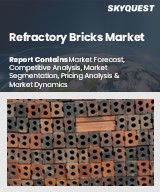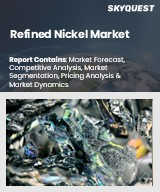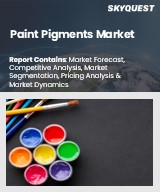
|
시장보고서
상품코드
1679604
니켈 선철(NPI) 시장 규모, 점유율, 동향 분석 보고서(2025-2030년) : 품위별, 최종 용도별, 지역별 부문 예측Nickel Pig Iron Market Size, Share & Trends Analysis Report By Grade (Low-grade, Medium-grade, High-grade), By End-use (Building & Construction, Automotive & Transportation), By Region, And Segment Forecasts, 2025 - 2030 |
||||||
니켈 선철(NPI) 시장의 성장과 동향
Grand View Research, Inc.의 최신 보고서에 따르면 니켈 선철 세계 시장 규모는 2030년까지 237억 9,000만 달러에 달할 것으로 예측되고, 2025-2030년의 CAGR은 4.8%를 나타낼 것으로 예측됩니다. 스테인레스 스틸과 합금 철 산업 수요가 계속 증가하면서 세계 시장은 역동적인 변화를 맞이할 것으로 예상됩니다. 2023년에는 스테인리스 생산량이 5,800만 톤을 초과하였고 NPI는 정제 니켈보다 비용면에서 유리하기 때문에 여전히 중요한 원료로 쓰이고 있습니다. 산업은 니켈 광석의 가용성 변동, 시책 중심 공급망 변화, 그리고 제련 기술의 발전에 영향을 받을 것으로 예상됩니다. 주요 제조업체들이 생산 능력을 확대함에 따라 시장 경쟁 중에서도 특히 인도네시아와 중국 제조업체 간의 경쟁이 치열해질 것으로 예상됩니다.
스테인리스 제조업체가 제품의 품질과 성능 향상에 주력하는 가운데 니켈 함량이 12%를 초과하는 고품위 NPI가 각광받을 것으로 예상됩니다. 아시아와 유럽의 인프라 투자가 증가함에 따라 건설 산업과 자동차 산업이 수요를 이끌 것으로 예상됩니다. 세계의 스테인리스 생산량의 50% 이상을 차지하는 중국에서는 현재 진행 중인 산업 개선 및 환경 대책에 의해 보다 고품위의 NPI에 대한 선호도가 변화하여 세계의 가격 정세에 영향을 미칠 가능성이 있습니다. 한편 생산 효율과 지속 가능성 대책은 미래 시장 포지셔닝에 영향을 미칠 것으로 보입니다.
니켈 함유량이 8% 이하인 저품위 NPI는 비용에 민감한 시장 중에서도 특히 저가격대의 스테인리스 용도에서 계속 중요한 역할을 할 것으로 예상됩니다. 가장 큰 생산국인 인도네시아는 2023년 NPI 생산량이 150만 톤을 돌파하였고 중국 공장에 대한 공급 능력을 강화하고 있습니다. 그러나, 배출 규제의 강화와 철강 생산에서 탈탄소로의 이동은 이 부문의 장기적인 성장에 어려움을 야기할 수 있습니다. 또한, 진화하는 무역역학과 수입국에 의한 잠재적인 관세 도입은 주요 공급업체의 수출 전략을 변화시킬 수 있습니다.
니켈 가격은 공급망의 제약, 지정학적 위험, 그리고 최종 이용 산업 수요 변동으로 인해 여전히 불안정해질 것으로 예상됩니다. 유럽 연합(EU)의 탄소 국경 조정 메커니즘(CBAM)은 탄소 집약적인 수입을 줄이기 위한 규제이며 고출력 가스 생산 기지에서 니켈 수출에 영향을 미칠 것으로 예상됩니다. 동시에 미국의 인플레이션 억제법과 전기자동차(EV)용 배터리를 위한 니켈 공급 확보를 위한 노력이 니켈 전체의 소비 패턴에 영향을 주어 간접적으로 NPI 수요를 형성할 가능성이 있습니다. 이러한 규제의 변화는 시장의 재구성과 생산 전략의 전환으로 이어질 수 있습니다.
세계 최대 소비국인 중국으로의 NPI 수입은 국내 생산이 환경 및 에너지 관련 규제에 직면하고 있기 때문에 높은 수준을 유지할 것으로 예상됩니다. 2023년에 수입한 NPI에는 30만 톤이 넘는 니켈이 포함되어 있기 때문에 인도네시아는 주요 공급국으로서의 우위를 유지할 것으로 보입니다. 그러나 니켈 매트 및 니켈 코발트 수산화혼합물(MHP)과 같은 대체 니켈 공급원에 대한 관심 증가는 미래 수입 동향에 영향을 줄 수 있습니다. 세계 공급망이 규제와 경제 상황의 변화에 적응해 나가는 가운데, 니켈 선철 제조업체는 지속 가능성의 과제에 임하면서 새로운 시장 기회를 모색해 나갈 것으로 예상됩니다.
니켈 선철(NPI) 시장 보고서 하이라이트
- 품위별로는 중품위 부문이 2024년 52.5%의 최대 수익 점유율로 시장을 선도하고 있습니다.
- 아시아태평양은 2024년 시장 매출 점유율에서 최대를 차지했습니다. 이 지역 시장은 왕성한 스테인리스 수요와 인도네시아의 제련 능력 확대에 견인되어 세계의 생산과 소비의 대부분을 차지할 것으로 예측됩니다.
- 세계 NPI 산업은 중국과 인도네시아가 총 생산량의 95% 이상을 차지하며 여전히 높은 집중도를 유지하고 있습니다. 산업 데이터에 따르면 인도네시아의 대중 NPI 수출은 2024년 150만 톤을 초과하면서 공급망의 우위를 강화하고 있습니다.
목차
제1장 조사 방법과 범위
제2장 주요 요약
제3장 시장의 변수, 동향, 범위
- 세계의 니켈 시장 전망
- 산업 밸류체인 분석
- 유통 채널 분석
- 기술 개요
- 규제 프레임워크
- 시장 역학
- 시장 성장 촉진요인 분석
- 시장 성장 억제요인 분석
- 시장 기회 분석
- Porter's Five Forces 분석
- 공급자의 협상력
- 구매자의 협상력
- 대체 위협
- 신규 참가업체의 위협
- 경쟁 기업간 경쟁 관계
- PESTLE 분석
- 정치
- 경제
- 사회
- 기술
- 환경
- 법률
제4장 니켈 선철(NPI) 시장 : 품위별, 추정 및 동향 분석
- 니켈 선철(NPI) 시장 : 품위 변동 분석(2024년 및 2030년)
- 저
- 중
- 고
제5장 니켈 선철(NPI) 시장 : 최종 용도별, 추정 및 동향 분석
- 니켈 선철(NPI) 시장 : 최종 용도 변동 분석(2024년 및 2030년)
- 건축 및 건설
- 자동차 및 운송
- 소비재
- 기계공학
- 기타
제6장 니켈 선철(NPI) 시장 : 지역별, 추정 및 동향 분석
- 지역 분석(2024년 및 2030년)
- 북미
- 품위별(2018-2030년)
- 최종 용도별(2018-2030년)
- 미국
- 캐나다
- 멕시코
- 유럽
- 품위별(2018-2030년)
- 최종 용도별(2018-2030년)
- 독일
- 이탈리아
- 스페인
- 아시아태평양
- 품위별(2018-2030년)
- 최종 용도별(2018-2030년)
- 중국
- 인도
- 일본
- 중남미
- 품위별(2018-2030년)
- 최종 용도별(2018-2030년)
- 브라질
- 중동 및 아프리카
- 품위별(2018-2030년)
- 최종 용도별(2018-2030년)
제7장 경쟁 구도
- 주요 시장 진출기업에 의한 최근 동향과 영향 분석
- 기업 분류
- 히트맵 분석
- 벤더 상황
- 장비 공급업체 목록
- 판매점 일람
- 잠재적 최종 사용자 목록
- 전략 이니셔티브
- 기업 프로파일/상장 기업
- New Yaking Pte. Ltd
- Tsingshan Group
- Nickel Industries Limited
- PT MERDEKA BATTERY MATERIALS TBK
- PT. Growth Java Industry
- PT. Gunbuster Nickel Industry(GNI)
- Shandong Xinhai
- Eramet
Nickel Pig Iron Market Growth & Trends:
The global nickel pig iron market size is anticipated to reach USD 23.79 billion by 2030 and is projected to grow at a CAGR of 4.8% from 2025 to 2030, according to a new report by Grand View Research, Inc. The global market is projected to experience dynamic shifts as demand from the stainless steel and ferroalloys industries continues to evolve. With stainless steel production exceeding 58 million metric tons in 2023, NPI remains a critical raw material due to its cost advantages over refined nickel. The industry is expected to be influenced by fluctuating nickel ore availability, policy-driven supply chain changes, and technological advancements in smelting. As major producers expand capacities, the market is anticipated to see heightened competition, particularly between Indonesian and Chinese manufacturers.
High-grade NPI, with nickel content exceeding 12%, is projected to gain prominence as stainless steel manufacturer's focus on improving product quality and performance. The construction and automotive industries are expected to be key drivers, with rising infrastructure investments in Asia and Europe supporting demand. In China, which accounts for over 50% of global stainless steel output, ongoing industrial upgrades and environmental initiatives may shift preferences toward higher-grade NPI, impacting the global pricing landscape. Meanwhile, production efficiencies and sustainability measures are likely to influence future market positioning.
The low-grade NPI segment, containing less than 8% nickel, is expected to remain relevant in cost-sensitive markets, particularly for lower-end stainless steel applications. Indonesia, the largest producer, saw its NPI output surpass 1.5 million metric tons in 2023, reinforcing its role in supplying China's mills. However, tightening emissions regulations and a shift toward decarbonization in steel production could challenge the segment's long-term growth. In addition, evolving trade dynamics and potential tariff implementations by importing countries may alter export strategies for key suppliers.
Nickel prices are projected to remain volatile due to supply chain constraints, geopolitical risks, and demand fluctuations in end-use industries. The European Union's Carbon Border Adjustment Mechanism (CBAM), aimed at reducing carbon-intensive imports, and is expected to impact NPI exports from high-emission production hubs. Concurrently, the U.S. Inflation Reduction Act and efforts to secure nickel supply for electric vehicle (EV) batteries could indirectly shape NPI demand by influencing overall nickel consumption patterns. These regulatory changes may lead to market realignments and shifts in production strategies.
Imports of NPI into China, the world's largest consumer, are projected to remain high as domestic production faces environmental and energy-related restrictions. With over 300,000 metric tons of nickel contained in imported NPI in 2023, Indonesia is set to maintain its dominance as the primary supplier. However, the growing focus on alternative nickel sources, including nickel matte and mixed hydroxide precipitate (MHP), could influence future import trends. As global supply chains adjust to evolving regulatory and economic conditions, NPI producers are expected to explore new market opportunities while addressing sustainability challenges.
Nickel Pig Iron Market Report Highlights:
- Based on grade, the medium-grade segment led the market with the largest revenue share of 52.5% in 2024, driven by its balanced cost-performance ratio and increasing preference from stainless steel manufacturers for enhanced durability in industrial applications.
- Asia Pacific dominated the market with the largest market revenue share in 2024. The market in this region is projected to dominate global production and consumption, driven by strong stainless steel demand and Indonesia's expanding smelting capacity.
- The global NPI industry remains highly concentrated, with China and Indonesia accounting for over 95% of total production. According to industry data, Indonesia's NPI exports to China exceeded 1.5 million metric tons in 2024, reinforcing its dominance in the supply chain.
Table of Contents
Chapter 1. Methodology and Scope
- 1.1. Market Segmentation & Scope
- 1.2. Market Definition
- 1.3. Information Procurement
- 1.3.1. Information Analysis
- 1.3.2. Data Analysis Models
- 1.3.3. Market Formulation & Data Visualization
- 1.3.4. Data Validation & Publishing
- 1.4. Research Scope and Assumptions
- 1.4.1. List of Data Sources
Chapter 2. Executive Summary
- 2.1. Market Outlook
- 2.2. Segmental Outlook
- 2.3. Competitive Outlook
Chapter 3. Market Variables, Trends, and Scope
- 3.1. Global Nickel Market Outlook
- 3.2. Industry Value Chain Analysis
- 3.2.1. Sales Channel Analysis
- 3.3. Technology Overview
- 3.4. Regulatory Framework
- 3.5. Market Dynamics
- 3.5.1. Market Driver Analysis
- 3.5.2. Market Restraint Analysis
- 3.5.3. Market Opportunity Analysis
- 3.6. Porter's Five Forces Analysis
- 3.6.1. Bargaining Power of Suppliers
- 3.6.2. Bargaining Power of Buyers
- 3.6.3. Threat of Substitution
- 3.6.4. Threat of New Entrants
- 3.6.5. Competitive Rivalry
- 3.7. PESTLE Analysis
- 3.7.1. Political
- 3.7.2. Economic
- 3.7.3. Social Landscape
- 3.7.4. Technology
- 3.7.5. Environmental
- 3.7.6. Legal
Chapter 4. Nickel Pig Iron Market: Grade Estimates & Trend Analysis
- 4.1. Nickel Pig Iron Market: Grade Movement Analysis, 2024 & 2030
- 4.2. Low-Grade
- 4.2.1. Market estimates and forecasts, 2018 - 2030 (Kilotons) (USD Million)
- 4.3. Medium-Grade
- 4.3.1. Market estimates and forecasts, 2018 - 2030 (Kilotons) (USD Million)
- 4.4. High-Grade
- 4.4.1. Market estimates and forecasts, 2018 - 2030 (Kilotons) (USD Million)
Chapter 5. Nickel Pig Iron Market: End Use Estimates & Trend Analysis
- 5.1. Nickel Pig Iron Market: End Use Movement Analysis, 2024 & 2030
- 5.2. Building & Construction
- 5.2.1. Market estimates and forecasts, 2018 - 2030 (Kilotons) (USD Million)
- 5.3. Automotive & Transportation
- 5.3.1. Market estimates and forecasts, 2018 - 2030 (Kilotons) (USD Million)
- 5.4. Consumer Goods
- 5.4.1. Market estimates and forecasts, 2018 - 2030 (Kilotons) (USD Million)
- 5.5. Mechanical Engineering
- 5.5.1. Market estimates and forecasts, 2018 - 2030 (Kilotons) (USD Million)
- 5.6. Others
- 5.6.1. Market estimates and forecasts, 2018 - 2030 (Kilotons) (USD Million)
Chapter 6. Nickel Pig Iron Market: Regional Estimates & Trend Analysis
- 6.1. Regional Analysis, 2024 & 2030
- 6.2. North America
- 6.2.1. Market estimates and forecasts, 2018 - 2030 (Kilotons) (USD Million)
- 6.2.2. Market estimates and forecasts, by grade, 2018 - 2030 (Kilotons) (USD Million)
- 6.2.3. Market estimates and forecasts, by end use, 2018 - 2030 (Kilotons) (USD Million)
- 6.2.4. U.S.
- 6.2.4.1. Market estimates and forecasts, 2018 - 2030 (Kilotons) (USD Million)
- 6.2.4.2. Market estimates and forecasts, by grade, 2018 - 2030 (Kilotons) (USD Million)
- 6.2.4.3. Market estimates and forecasts, by end use, 2018 - 2030 (Kilotons) (USD Million)
- 6.2.5. Canada
- 6.2.5.1. Market estimates and forecasts, 2018 - 2030 (Kilotons) (USD Million)
- 6.2.5.2. Market estimates and forecasts, by grade, 2018 - 2030 (Kilotons) (USD Million)
- 6.2.5.3. Market estimates and forecasts, by end use, 2018 - 2030 (Kilotons) (USD Million)
- 6.2.6. Mexico
- 6.2.6.1. Market estimates and forecasts, 2018 - 2030 (Kilotons) (USD Million)
- 6.2.6.2. Market estimates and forecasts, by grade, 2018 - 2030 (Kilotons) (USD Million)
- 6.2.6.3. Market estimates and forecasts, by end use, 2018 - 2030 (Kilotons) (USD Million)
- 6.3. Europe
- 6.3.1. Market estimates and forecasts, 2018 - 2030 (Kilotons) (USD Million)
- 6.3.2. Market estimates and forecasts, by grade, 2018 - 2030 (Kilotons) (USD Million)
- 6.3.3. Market estimates and forecasts, by end use, 2018 - 2030 (Kilotons) (USD Million)
- 6.3.4. Germany
- 6.3.4.1. Market estimates and forecasts, 2018 - 2030 (Kilotons) (USD Million)
- 6.3.4.2. Market estimates and forecasts, by grade, 2018 - 2030 (Kilotons) (USD Million)
- 6.3.4.3. Market estimates and forecasts, by end use, 2018 - 2030 (Kilotons) (USD Million)
- 6.3.5. Italy
- 6.3.5.1. Market estimates and forecasts, 2018 - 2030 (Kilotons) (USD Million)
- 6.3.5.2. Market estimates and forecasts, by grade, 2018 - 2030 (Kilotons) (USD Million)
- 6.3.5.3. Market estimates and forecasts, by end use, 2018 - 2030 (Kilotons) (USD Million)
- 6.3.6. Spain
- 6.3.6.1. Market estimates and forecasts, 2018 - 2030 (Kilotons) (USD Million)
- 6.3.6.2. Market estimates and forecasts, by grade, 2018 - 2030 (Kilotons) (USD Million)
- 6.3.6.3. Market estimates and forecasts, by end use, 2018 - 2030 (Kilotons) (USD Million)
- 6.4. Asia Pacific
- 6.4.1. Market estimates and forecasts, 2018 - 2030 (Kilotons) (USD Million)
- 6.4.2. Market estimates and forecasts, by grade, 2018 - 2030 (Kilotons) (USD Million)
- 6.4.3. Market estimates and forecasts, by end use, 2018 - 2030 (Kilotons) (USD Million)
- 6.4.4. China
- 6.4.4.1. Market estimates and forecasts, by grade, 2018 - 2030 (Kilotons) (USD Million)
- 6.4.4.2. Market estimates and forecasts, by end use, 2018 - 2030 (Kilotons) (USD Million)
- 6.4.5. India
- 6.4.5.1. Market estimates and forecasts, by grade, 2018 - 2030 (Kilotons) (USD Million)
- 6.4.5.2. Market estimates and forecasts, by end use, 2018 - 2030 (Kilotons) (USD Million)
- 6.4.6. Japan
- 6.4.6.1. Market estimates and forecasts, by grade, 2018 - 2030 (Kilotons) (USD Million)
- 6.4.6.2. Market estimates and forecasts, by end use, 2018 - 2030 (Kilotons) (USD Million)
- 6.5. Central & South America
- 6.5.1. Market estimates and forecasts, 2018 - 2030 (Kilotons) (USD Million)
- 6.5.2. Market estimates and forecasts, by grade, 2018 - 2030 (Kilotons) (USD Million)
- 6.5.3. Market estimates and forecasts, by end use, 2018 - 2030 (Kilotons) (USD Million)
- 6.5.4. Brazil
- 6.5.4.1. Market estimates and forecasts, by grade, 2018 - 2030 (Kilotons) (USD Million)
- 6.5.4.2. Market estimates and forecasts, by end use, 2018 - 2030 (Kilotons) (USD Million)
- 6.6. Middle East & Africa
- 6.6.1. Market estimates and forecasts, 2018 - 2030 (Kilotons) (USD Million)
- 6.6.2. Market estimates and forecasts, by grade, 2018 - 2030 (Kilotons) (USD Million)
- 6.6.3. Market estimates and forecasts, by end use, 2018 - 2030 (Kilotons) (USD Million)
Chapter 7. Competitive Landscape
- 7.1. Recent Developments & Impact Analysis, By Key Market Participants
- 7.2. Company Categorization
- 7.3. Heat Map Analysis
- 7.4. Vendor Landscape
- 7.4.1. List of equipment suppliers
- 7.4.2. List of distributors
- 7.5. List of Prospective End-Users
- 7.6. Strategy Initiatives
- 7.7. Company Profiles/Listing
- 7.7.1. New Yaking Pte. Ltd
- 7.7.1.1. Company Overview
- 7.7.1.2. Financial Performance
- 7.7.1.3. Product Benchmarking
- 7.7.2. Tsingshan Group
- 7.7.2.1. Company Overview
- 7.7.2.2. Financial Performance
- 7.7.2.3. Product Benchmarking
- 7.7.3. Nickel Industries Limited
- 7.7.3.1. Company Overview
- 7.7.3.2. Financial Performance
- 7.7.3.3. Product Benchmarking
- 7.7.4. PT MERDEKA BATTERY MATERIALS TBK
- 7.7.4.1. Company Overview
- 7.7.4.2. Financial Performance
- 7.7.4.3. Product Benchmarking
- 7.7.5. PT. Growth Java Industry
- 7.7.5.1. Company Overview
- 7.7.5.2. Financial Performance
- 7.7.5.3. Product Benchmarking
- 7.7.6. PT. Gunbuster Nickel Industry (GNI)
- 7.7.6.1. Company Overview
- 7.7.6.2. Financial Performance
- 7.7.6.3. Product Benchmarking
- 7.7.7. Shandong Xinhai
- 7.7.7.1. Company Overview
- 7.7.7.2. Financial Performance
- 7.7.7.3. Product Benchmarking
- 7.7.8. Eramet
- 7.7.8.1. Company Overview
- 7.7.8.2. Financial Performance
- 7.7.8.3. Product Benchmarking
- 7.7.1. New Yaking Pte. Ltd
(주말 및 공휴일 제외)


















